Plot summary
The play takes place during a midsummer feast on a valley farm in Telemark. Here, we find two very different attitudes symbolized in the old farm house and a new house. The farm house is inhabited by the old farmer, Berg, and his granddaughter Anne. The new house is inhabited by Anne's stepmother, Mrs. Berg, and her daughter from a previous marriage, Juliane. At the time of the play, Anne's father is dead, and there is a big question as to what will come of his inheritance. The second Mrs. Berg wishes for her daughter to inherit the farm and has found her a suitor from town, Johannes Birk. He arrives with Juliane's brother Jørgen, and a fellow student, Julian Paulsen. The young ones assemble for a trip to the hill of St. John (Sankthanshaugen), to take part in the revels of rural festivity. Jørgen prepares the punch, but the people are not aware of the nisse, who lives in the attic of the old house. He mixes the liquor with a mystical flower, with the virtue of remembrance for those who have forgotten their past.
The young ones wander away after tasting the liquor. Anne walks with Birk, Julian with Juliane. As the night wears on, elves dance in the forest, and Anne finds a flower, in Norwegian called "Keys of St. Mary". With this, she orders the mountain to open, and the couples witness a play within a play, an old ballad about a girl who was abducted into the mountain by the mountain king and drank a cup of forgetfulness. Anne, who was brought up on old folklore and songs, recognizes the verses. She is surprised to learn that Birk knows them too. Paulsen, on the other hand, interprets the mountain king as a "Fine gentleman of the upper classes", from his own town.
After this play, Anne recognizes Birk as her childhood friend, and Julian recognizes Juliane from a dancing school in the city. The day after, the "right" couples decide to engage, which disrupts Mrs. Berg's plans of ruling the farm through Birk. The flower Anne found has turned into a real key, and with this, her grandfather opens a box containing her father's will, long lost. This states her rightful inheritance when marrying, and Mrs. Berg is beaten in the end. Anne marries Birk, Julian marries Juliane and all are happy about the change in plans. The real winner is the nisse, who planned it all from behind.
Reception and criticism
The comical figure of Julian Paulsen was at the time a satirical comment on the regular urban romantic, such as Johan Sebastian Welhaven. Julian is a romantic nationalist, pining for the hulder in the Norwegian forests. He is heartbroken because the fairy tales edited by Asbjørnsen and Moe claimed that hulders have a cow's tail. The editors, Julian states, are "inhuman" because of this.
Ibsen, through some of the protagonists, seems to think Julian is far from the truth of both folklore and rural life, and as the play goes on, we learn that he is unable to tolerate the farmers at all. The satire was clear, and the public reacted with scorn. They felt offended, and the play was not well received. Ibsen himself stated that the whole gang of critics thought like Julian and decided not to offend them again. Therefore, St. John's Eve was never printed in his "collected works", and not performed again until 1978, under the supervision of Ingeborg Refling Hagen. Since then, it has been played by youth theater groups and children alike, and only twice by an adult commercial theater.
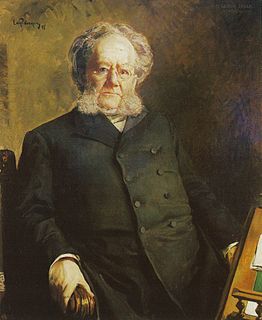
Henrik Johan Ibsen was a Norwegian playwright and theatre director. As one of the founders of modernism in theatre, Ibsen is often referred to as "the father of realism" and one of the most influential playwrights of his time. His major works include Brand, Peer Gynt, An Enemy of the People, Emperor and Galilean, A Doll's House, Hedda Gabler, Ghosts, The Wild Duck, When We Dead Awaken, Rosmersholm, and The Master Builder. He is the most frequently performed dramatist in the world after Shakespeare, and A Doll's House was the world's most performed play in 2006.

In English folklore, Puck, sometimes known as Robin Goodfellow, is a domestic and nature sprite, demon, or fairy.
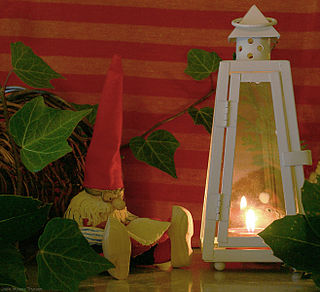
A nisse, tomte, tomtenisse, or tonttu is a mythological creature from Nordic folklore today typically associated with the winter solstice and the Christmas season. They are generally described as being short, having a long white beard, and wearing a conical or knit cap in red or some other bright colour. They often have an appearance somewhat similar to that of a garden gnome.
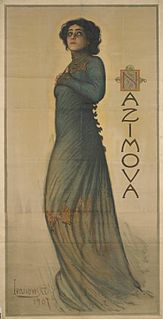
Hedda Gabler is a play written by Norwegian playwright Henrik Ibsen. The world premiere was staged on 31 January 1891 at the Residenztheater in Munich. Ibsen himself was in attendance, although he remained backstage. The play has been canonized as a masterpiece within the genres of literary realism, nineteenth century theatre, and world drama. Ibsen mainly wrote realistic plays until his forays into modern drama. Hedda Gabler is a captivating and well-known play from the 1890s that dramatizes the experiences of the title character, Hedda, the daughter of a general, who is trapped in a marriage and a house that she does not want. Overall, the title character for Hedda Gabler is considered one of the great dramatic roles in theater. The year following its publication, the play received negative feedback and reviews. Hedda Gabler has been described as a female variation of Hamlet.
Scandinavian folklore or Nordic folklore is the folklore of Norway, Sweden, Denmark, Iceland and the Faroe Islands. It has common roots with, and has been mutually influenced by, folklore in England, Germany, the Baltic countries, Finland and Sapmi. Folklore is a concept encompassing expressive traditions of a particular culture or group. The peoples of Scandinavia are heterogenous, as are the oral genres and material culture that has been common in their lands. However, there are some commonalities across Scandinavian folkloric traditions, among them a common ground in elements from Norse mythology as well as Christian conceptions of the world.
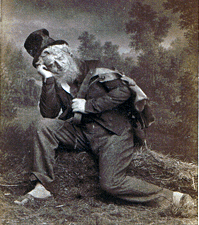
Peer Gynt is a five-act play in verse by the Norwegian dramatist Henrik Ibsen published in 1867. Written in Danish—the common written language of Denmark and Norway in Ibsen's lifetime—it is one of the most widely performed Norwegian plays. Ibsen believed Per Gynt, the Norwegian fairy tale on which the play is loosely based, to be rooted in fact, and several of the characters are modelled after Ibsen's own family, notably his parents Knud Ibsen and Marichen Altenburg. He was also generally inspired by Peter Christen Asbjørnsen's collection of Norwegian fairy tales, published in 1845.

The Master Builder is a play by Norwegian playwright Henrik Ibsen.

The vættir are spirits in Norse mythology. The term can be used to refer to the full cosmos of supernatural beings, including the álfar (elves), dvergar (dwarves), jötnar (giants), and gods. Vættir can also refer more specifically to landvættir, fjallvættir, sjóvættir, skogvættir , vatnavættir, or húsvættir.

Hermia is a fictional character from Shakespeare's play, A Midsummer Night's Dream. She is a girl of ancient Athens named for Hermes, the Greek god of trade.

Little Eyolf is an 1894 play by Norwegian playwright Henrik Ibsen. The play was first performed on January 12, 1895 in the Deutsches Theater in Berlin.

The Telemark Museum is located in Kleiva in the older part of Skien in Vestfold og Telemark county, Norway. Telemark Museum is located within walking distance of downtown Skien.

Five Get into a Fix is a children's novel written by Enid Blyton and published by Hodder and Stoughton in 1958. It is the seventeenth book in the Famous Five series.

Henrich Krummedige, was born circa 1464 in Norway and died in 1530. He was a Danish-Norwegian nobleman and a member of both the Norwegian and Danish National Councils (Rigsråd) and played an extensive role in the politics of the era. He served as commanding officer of the Bohus Fortress in Norway from 1489 to 1503.
Papegøien is a farce from 1835, written by Norwegian writer Henrik Wergeland under the pseudonym "Siful Sifadda".

Paul Botten-Hansen was a Norwegian librarian, book collector, magazine editor and literary critic.
Kristine Cathrine Ploug (1760–1837), known as Aunt Ploug, was a relative of playwright Henrik Ibsen, cited as the influence of some of the characters in his plays, such as The Rat-Wife in Little Eyolf. She was a sister of Johan Andreas Altenburg, Ibsen's maternal grandfather, and as such the aunt of Marichen Altenburg and great-aunt of Henrik Ibsen. She lived with her brother from around 1799, following the death of her husband, and after Johan Andreas Altenburg's death, she lived with the Ibsen family. She died at Venstøp in 1837.
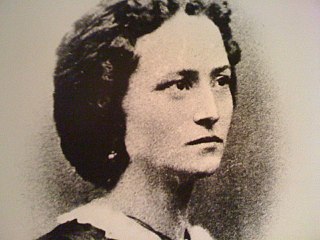
Fredrikke Louise Nielsen, was a popular actress and a women's pioneer. She played more than 300 roles in her twenty-six-year-long career, and was personally directed by both Henrik Ibsen and Bjørnstjerne Bjørnson. Ibsen chose her to play Signe, one of the lead characters in The Feast at Solhaug (1856), which was his first audience success. In 1880, Nielsen left the stage and joined the Methodist Movement in Bergen. She now became a preacher, first in Scandinavia, and later in the United States. She felt a strong social commitment and used the pulpit for preaching other topics than religion, such as women's and children's rights.
The Dream is a one-act ballet adapted from Shakespeare's A Midsummer Night's Dream, with choreography by Frederick Ashton to music by Mendelssohn arranged by John Lanchbery. It was premiered by The Royal Ballet at the Royal Opera House, Covent Garden on 2 April 1964 in a triple bill with Kenneth MacMillan's Images of Love and Robert Helpmann's Hamlet.
Milja Salovaara is a Finnish costume designer and scenographer/set designer. She has done work in Norway, Sweden and Finland.

Hedda Gabler is a film based on the 1891 Victorian period play Hedda Gabler, written by Norwegian playwright Henrik Ibsen. One of many adaptations of this play, the film Hedda Gabler was produced, adapted and directed by Matthew John. Hedda Gabler is an example of realism in nineteenth century play writing, and is one of the world's best known and most performed dramas. The film was shot at Maunsel House.













